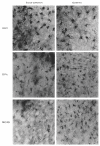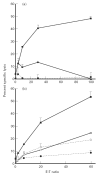The murine buccal mucosa is an inductive site for priming class I-restricted CD8+ effector T cells in vivo
- PMID: 9737667
- PMCID: PMC1905068
- DOI: 10.1046/j.1365-2249.1998.00671.x
The murine buccal mucosa is an inductive site for priming class I-restricted CD8+ effector T cells in vivo
Abstract
The present study shows that Langerhans cells of the buccal mucosa and the skin share a similar phenotype, including in situ expression of MHC class II, the mannose receptor DEC-205 and CD11c, and absence of the costimulatory molecules B7.1, B7.2 and CD40 as well as Fas. Application of 2,4-dinitrofluorobenzene (DNFB) onto the buccal mucosa is associated with a rapid migration of dendritic cells (DC) to the epithelium and induction of B7.2 expression on some DC. Buccal sensitization with DNFB elicited a specific contact sensitivity (CS) in response to skin challenge, mediated by class I-restricted CD8+ effector T cells and down-regulated by class II-restricted CD4+ T cells, demonstrated by the lack of priming of class I-deficient mice and the enhanced response of class II-deficient mice, respectively. CS induced by buccal immunization is associated with priming of class I-restricted CD8+ effector T cells endowed with hapten-specific cytotoxic activity. Thus, the buccal epithelium is an inductive site, equivalent to the epidermis, for the generation of CS independent of CD4 help, and of cytotoxic T lymphocyte (CTL) responses mediated by class I-restricted CD8+ T cells. We propose that immunization through the buccal mucosa, which allows antigen presentation by epithelial DC efficient for priming systemic class I-restricted CD8+ CTL, may be a valuable approach for single-dose mucosal vaccination with subunit vaccines.
Figures






Similar articles
-
Dual role of dendritic cells in the induction and down-regulation of antigen-specific cutaneous inflammation.J Immunol. 1998 Feb 1;160(3):1181-90. J Immunol. 1998. PMID: 9570532
-
Dendritic cells recruitment and in vivo priming of CD8+ CTL induced by a single topical or transepithelial immunization via the buccal mucosa with measles virus nucleoprotein.J Immunol. 2001 Jul 1;167(1):384-91. doi: 10.4049/jimmunol.167.1.384. J Immunol. 2001. PMID: 11418674
-
Dendritic cells in distinct oral mucosal tissues engage different mechanisms to prime CD8+ T cells.J Immunol. 2011 Jan 15;186(2):891-900. doi: 10.4049/jimmunol.1002943. Epub 2010 Dec 15. J Immunol. 2011. PMID: 21160044
-
Major histocompatibility complex class I-restricted CD8+ T cells and class II-restricted CD4+ T cells, respectively, mediate and regulate contact sensitivity to dinitrofluorobenzene.Eur J Immunol. 1995 Nov;25(11):3006-10. doi: 10.1002/eji.1830251103. Eur J Immunol. 1995. PMID: 7489735
-
Dendritic cells as stimulator cells of MHC class I-restricted immune responses.Adv Exp Med Biol. 1995;378:341-5. doi: 10.1007/978-1-4615-1971-3_76. Adv Exp Med Biol. 1995. PMID: 8526088 Review.
Cited by
-
Direct intranodal tonsil vaccination with modified vaccinia Ankara vaccine protects macaques from highly pathogenic SIVmac251.Nat Commun. 2023 Mar 7;14(1):1264. doi: 10.1038/s41467-023-36907-0. Nat Commun. 2023. PMID: 36882405 Free PMC article.
-
Intra-cheek immunization as a novel vaccination route for therapeutic vaccines of head and neck squamous cell carcinomas using plasmo virus-like particles.Oncoimmunology. 2016 Jul 6;5(7):e1164363. doi: 10.1080/2162402X.2016.1164363. eCollection 2016 Jul. Oncoimmunology. 2016. PMID: 27622018 Free PMC article.
-
Langerhans cell-like dendritic cells in the cornea, tongue and oesophagus of the chicken (Gallus gallus).Histochem J. 2002 Oct;34(10):507-15. doi: 10.1023/a:1024714107373. Histochem J. 2002. PMID: 12945733
-
Immunopathogenesis of oropharyngeal candidiasis in human immunodeficiency virus infection.Clin Microbiol Rev. 2004 Oct;17(4):729-59, table of contents. doi: 10.1128/CMR.17.4.729-759.2004. Clin Microbiol Rev. 2004. PMID: 15489345 Free PMC article. Review.
-
Dendritic cells and the handling of antigen.Clin Exp Immunol. 2003 Nov;134(2):178-80. doi: 10.1046/j.1365-2249.2003.02279.x. Clin Exp Immunol. 2003. PMID: 14616774 Free PMC article. No abstract available.
References
-
- Butcher EC. The regulation of lymphocyte traffic. Curr Top Microbiol Immunol. 1986;128:85–95. - PubMed
-
- Gowans JL, Knight EJ. The route of re-circulation of lymphocytes in the rat. Proc R Soc Lond B. 1964;159:257–3. - PubMed
-
- McDermott MR, Bienenstock J. Evidence for a common mucosal immunological system. I. Migration of B immunoblasts into intestinal, respiratory, and genital tissues. J Immunol. 1979;122:1892–7. - PubMed
Publication types
MeSH terms
Substances
LinkOut - more resources
Full Text Sources
Research Materials
Miscellaneous

